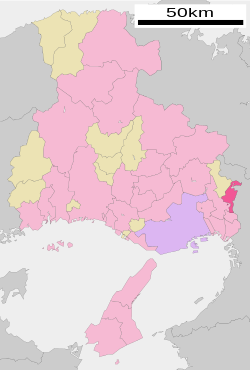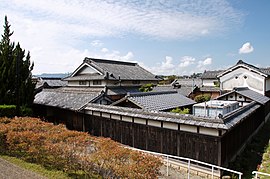| Kawanishi 川西市 | |
|---|---|
| City | |
 Kawanishi City Hall Kawanishi City Hall | |
 Flag Flag Emblem Emblem | |
| Location of Kawanishi in Hyōgo Prefecture | |
 | |
 | |
| Coordinates: 34°50′N 135°25′E / 34.833°N 135.417°E / 34.833; 135.417 | |
| Country | Japan |
| Region | Kansai |
| Prefecture | Hyōgo |
| Government | |
| • Mayor | Tamio Oshio |
| Area | |
| • Total | 53.44 km (20.63 sq mi) |
| Population | |
| • Total | 155,165 |
| • Density | 2,900/km (7,500/sq mi) |
| Time zone | UTC+09:00 (JST) |
| City hall address | 12-1 Chūō-chō, Kawanishi-shi, Hyōgo-ken 666-8501 |
| Website | Official website |
| Symbols | |
| Flower | Gentian |
| Tree | Sakura |



Kawanishi (川西市, Kawanishi-shi) is a city located in Hyōgo Prefecture, Japan. As of 30 September 2022, the city had an estimated population of 155,165 and a population density of 2900 persons per km². The total area of the city is 53.44 square kilometres (20.63 sq mi).
Geography
Kawanishi is located in far eastern Hyōgo Prefecture, about 5 km north of Osaka Itami Airport. It is bordered on the west by the Inagawa river.
Neighbouring municipalities
Hyōgo Prefecture
Osaka Prefecture
Climate
Kawanishi has a Humid subtropical climate (Köppen Cfa) characterized by warm summers and cool winters with light snowfall. The average annual temperature in Kawanishi is 14.0 °C. The average annual rainfall is 14759 mm with September as the wettest month. The temperatures are highest on average in January, at around 25.8 °C, and lowest in January, at around 2.6 °C.
Demographics
Per Japanese census data, the population of Kawanishi has been increasing steadily since the 1920s.
| Year | Pop. | ±% |
|---|---|---|
| 1920 | 13,951 | — |
| 1930 | 17,039 | +22.1% |
| 1940 | 22,411 | +31.5% |
| 1950 | 32,555 | +45.3% |
| 1960 | 41,916 | +28.8% |
| 1970 | 87,127 | +107.9% |
| 1980 | 129,834 | +49.0% |
| 1990 | 141,253 | +8.8% |
| 2000 | 153,763 | +8.9% |
| 2010 | 156,476 | +1.8% |
History
The area of Kawanishi was part of ancient Kawabe District of Settsu Province and has been inhabited since ancient times, with the traces of a Yayoi period settlement many kofun burial mounds found within the city limits. From the Heian period, the Tada-in was a sacred site for the Seiwa Genji clan after Minamoto no Mitsunaka, a grandson of Emperor Seiwa retired to this area. From the 11th century, the Tada Silver Mine, which produced silver and copper, started. It reached peak production the 17th century, which is why this area was tenryō territory under the direct administration of the Tokugawa shogunate in the Edo period. The village of Kawanishi was established on April 1, 1889 with the creation of the modern municipalities system. It was elevated to town status on October 1, 1925. On August 1 1954 it merged with the villages of Higashitani (東谷村) and Tada (多田村) to become the city of Kawanishi.
Government
Kawanishi has a mayor-council form of government with a directly elected mayor and a unicameral city council of 26 members. Kawanishi contributes three members to the Hyōgo Prefectural Assembly. In terms of national politics, the city is divided between the Hyōgo th district and Hyōgo 6th districts of the lower house of the Diet of Japan.
Economy
In 1884, Mitsubishi established Japan's first noted water plant in Kawanishi, this later became Mitsuya Cider. At present, Kawanishi is a commuter town for workers in Kobe and Osaka, with express trains running from Osaka to Kawanishi to accommodate these travelers. Though primarily suburban, Kawanishi does have a significant agricultural sector, especially in the northern portions of the city. Major crops include peaches, chestnuts, figs, and charcoal.
Education
Kawanishi has 16 public elementary schools and eight public middle schools operated by the city government, and four public high schools operated by the Hyōgo Prefectural Board of Education. In addition, the city also operates one special education school for the handicapped. The Toyo College of Food Technology, a junior college, is located in the city
Transportation
Railways
Kawanishi is serviced by the JR Takarazuka Line and the Hankyu Takarazuka Line. Hankyu's Kawanishi-Noseguchi Station is a transfer station to the Nose Railway, which runs primarily within Kawanishi.
![]() Nose Electric Railway - Myōken Line
Nose Electric Railway - Myōken Line
- Kawanishi-noseguchi - Kinunobebashi - Takiyama - Uguisunomori - Tsuzumigataki - Tada - Hirano - Ichinotorii - Uneno - Yamashita - Sasabe
![]() Nose Electric Railway - Nissei Line
Nose Electric Railway - Nissei Line
Highways
 Shin-Meishin Expressway Kawanishi Interchange
Shin-Meishin Expressway Kawanishi Interchange Chūgoku Expressway
Chūgoku Expressway Hanshin Expressway Ikeda Route
Hanshin Expressway Ikeda Route
Sister cities
 Bowling Green, Kentucky, United States, since 1992
Bowling Green, Kentucky, United States, since 1992 Sawara, Chiba, Japan, since 1990
Sawara, Chiba, Japan, since 1990
Local attractions

(Folk Museum of Kawanishi)
- Folk Museum of Kawanishi
- Hitokura Dam and Lake Chimyo
- Inagawa Keikoku Prefectural Natural Park
- Kamo Site, National Historic Monument
- Mangan-ji, Buddhist temple
- Shinden Castle ruins
- Shofukuji Kofun
- Tada-in
- Yamashita Castle ruins
Notable people from Kawanishi
- Atsuya Furuta
- Haruna Hosoya
- Masafumi Kawaguchi
- Hideo Kojima
- Miyavi
- Hiroyuki Noritake
- Wakakirin Shinichi
- Kana Uemura
- Kaoru Yumi
References
- "Kawanishi city official statistics" (in Japanese). Japan.
- "【川西市】秋のキセラ★フェスタ2022と都市緑化祭を同時開催". プレスリリース・ニュースリリース配信シェアNo.1|PR TIMES. Retrieved 2022-10-21.
- Kawanishi climate data
- Kawanishi population statistics
- Hashimoto, Naoto. "Famous carbonated water sites keep their fizz". inkl. Retrieved 2022-10-21.
External links
 Media related to Kawanishi, Hyōgo at Wikimedia Commons
Media related to Kawanishi, Hyōgo at Wikimedia Commons- Kawanishi City official website (in Japanese)
- Kawanishi City official website (in English)
| Kobe (capital) | ||||
| Kobe |
| |||
| Core cities | ||||
| Special cities | ||||
| Cities | ||||
| Districts | ||||
| List of mergers in Hyōgo Prefecture | ||||